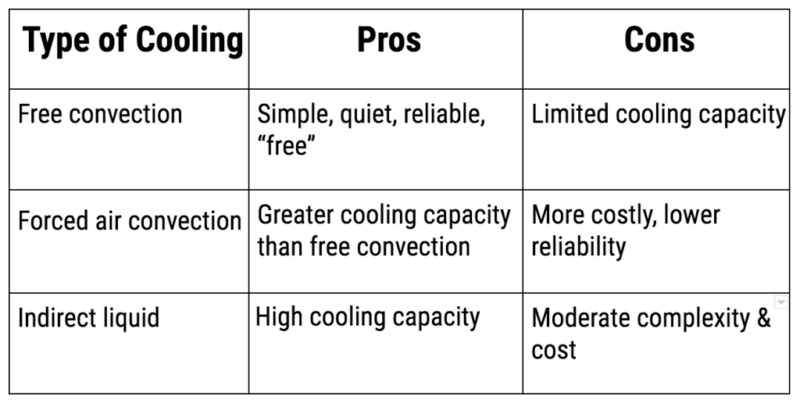What Are The Different Types of Liquid Cooling?
Due to higher densities, specific heat capacities, and thermal conductivities, liquids are generally much better cooling agents than gases. Compared to air, water has a heat carrying capacity 3,500 times higher than that of air, and a thermal conductivity 24 times greater. This makes liquid cooling far more efficient than air cooling.
Liquid Cooling
A liquid cooled system uses a pump to force a fluid through a piping system that's in close proximity to the heated components. Heat travels by conduction from the heat producing component to the liquid. It's then transferred from the pipe to the coolant by convection.
Liquid cooling is one of the most efficient means to remove heat from a part. It has advantages in thermal efficiency, power density, and thermal isolation. A part that is liquid cooled is thermally isolated from its surroundings, meaning the heat it gives off does not directly impact the temperature of other electronics in the enclosure.
Liquid cooled systems requires additional components to manage the movement of the coolant (pump) and to remove heat from the coolant (heat exchanger). These components are essential to a liquid cooled system. Liquid cooled systems must be designed to avoid leakage and corrosion. Heat exchangers must be properly sized for the application to avoid overheating
Traditionally, liquid cooling is used when power density is too high for safe dissipation by air cooling. Liquid cooling was once considered too costly for other applications. However, recent design and manufacturing advances have allowed CTM Magnetics to produce liquid cooled magnetics solutions that are cheaper than equivalent air cooled designs in many high power applications.
Immersed Liquid Cooling
An immersed liquid cooled system puts the heat-producing components into direct contact with a cooling liquid. Heat travels directly to the liquid through convection. In this system, it is important that the coolant not be electrically conductive.
Heat can be removed from the coolant in several ways. Much like in an automobile, the coolant can be pumped to a heat exchanger (radiator), then cooled and recirculated. Alternatively, heat can transfer passively from the liquid to the enclosure, with the enclosure cooling by natural convection to the surrounding air; this is how power transformers on utility power lines are cooled.
Finally, a separate liquid cooled system can be placed within the cooling fluid in an immersed cooling system. In that model, heat flows from the electronic device, into the cooling fluid, then into a piping system where it is removed from the enclosure. In effect, the pumped coolant chills the static coolant. This double cooling system has the advantage that the pumped fluid does not need to be an insulator. Additionally, “transformer oil” is expensive, and leads to accelerated wear in pumps.
Some immersed liquid cooled systems have high thermal efficiencies without any moving parts (though lower than traditional liquid cooling). The double liquid immersed system described above has some of the highest thermal efficiencies available. The primary drawback of immersed liquid cooled systems is their high or very high cost.
Heat Sinks, Chill Plates
Heat sinks and chill plates are frequently used in high power electrical systems. Both these systems provide a flat, cooled surface for integration of electrical equipment. Heat is transferred from the integrated component to the cooled surface by conduction. Heat is then transferred conductively through the heat sink/chill plate to the cooling medium.
In heat sinks, fins (with high surface area) convect heat to the air. The fins can either convect heat naturally, or air can be forced across the fins to boost heat transfer.
Where substantial heat must be drawn away from solid state components, a chill plate works well. A chill plate is a metallic plate fitted with cooling tubes (or internal cavities) that carry a liquid coolant. Chill plates transfer heat to the pumped coolant via convection.
*Note - Some magnetics suppliers advertise “liquid cooled” systems which include an integrated heat sink. These systems have lower thermal efficiency than CTM’s liquid cooled magnetics due to higher thermal impedance to the coolant.
Not any part can be mounted directly to a heat sink or chill plate. Heat sink integrated components have a flat surface for better thermal integration with the heat sink, and low thermal impedance between the component and that interface.
Heat sink integrated solutions are ideal for cabinets and enclosures that already contain a heat sink or chill plate. Both heat sink and chill plate integrated solutions are more efficient than air cooling, but less efficient than liquid cooling.
Phase Change Cooling
Phase change cooling, also known as vapor cooling, refers to the fact that the coolant changes from a liquid to a gas—a phase change—as the process unfolds. Phase change cooling follows the same principles as traditional refrigeration units. [3]
A compressor condenses a refrigerant gas into its liquid form. A pump moves the liquid to a vaporizer where pressure is reduced and the liquid returns to a gaseous state, absorbing large amounts of heat energy. The heated gas is cycled through a radiator that releases heat by convection, then passes to the compressor where the cycle is repeated. This type of cooling can produce temperatures sufficient to freeze water. [2]
Phase change cooling systems can chill electrical components to far lower temperatures than other designs. However because it requires compressors, vaporizers and electrical power, it is the most expensive method and perhaps more likely to fail due to its many moving parts. Phase change cooling is generally reserved for cooling high-cost computer CPUs.

CTM Magnetics pioneered liquid cooled inductors in 2006. Since then we have continued to improve liquid cooling technology, and have redefined the limits of heat transfer in power electronics. Today, ourReact LF Liquid Cooled Line Reactors cost less than their air cooled counterparts, while maintaining substantially higher heat transfer rates.
Contact us to learn how liquid cooling can work for you.
 " alt="">
" alt="">